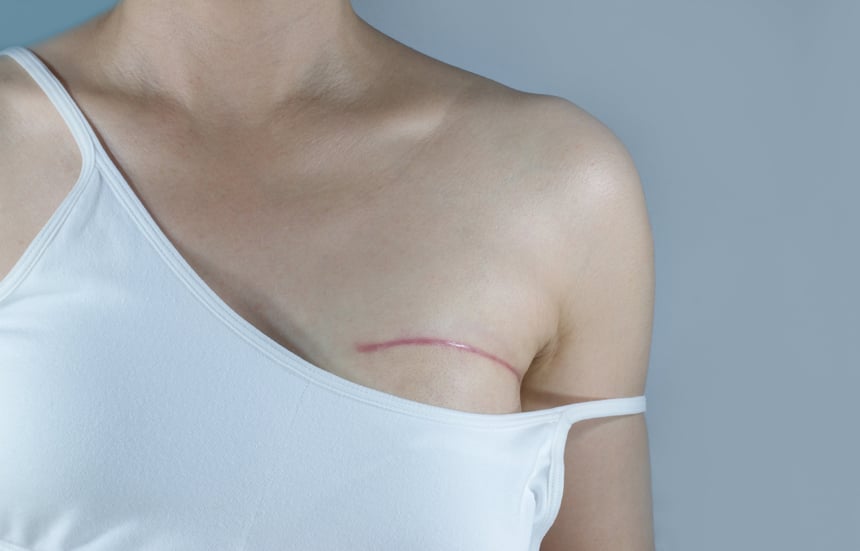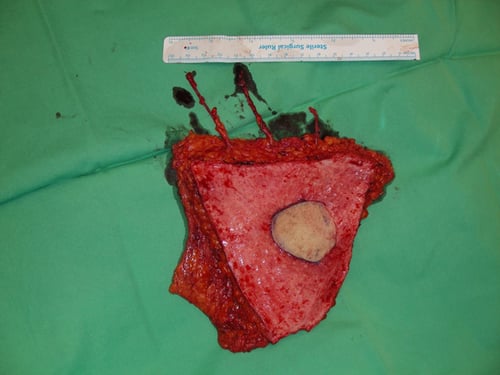Patient Stories
Bilateral breast reconstruction using abdominal free flaps

A 45-year-old mother of 2 children was diagnosed with left breast cancer, for which a skin-sparing mastectomy (total removal of breast tissue leaving behind the skin envelope) was recommended.
Genetic investigations revealed that she had a high genetic risk for development of breast cancer, and she therefore chose to have both her breasts removed.
She was then referred to Dr Adrian by the breast surgeon for consideration of post-mastectomy reconstruction.
An assessment revealed excess skin and fat at the abdomen as a result of her previous pregnancies, suitable in size to replace both breasts, which made her a good candidate for reconstruction using her own tissue using an abdominal based flap. She was further counselled for a free (98.5% success rate) versus pedicled flap (99.9% success rate) approach, with the latter requiring sacrifice of the abdominal rectus (six-pack) muscles.
She chose bilateral free flap breast reconstruction using her abdominal skin and fat, which would involve halving the abdominal ellipse and using each half to reconstruct the right and left breasts.
Prior to the operation, a CT-angiogram was performed to delineate the vascular supply to the abdominal wall skin and fat, which provided a road map and made the surgery quicker. The most common method and gold standard of free abdominal flap reconstruction would have been to utilize the deep inferior epigastric vessels, making a small cut in the abdominal fascia and sparing all the muscle, and she was planned for this.
During the actual operation, she was found to have suitable superficial inferior epigastric artery (SIEA) and vein (SIEV), negating the need to enter the abdominal fascia. Thus, both sides of the abdominal skin and fat were harvested leaving the entire abdominal muscle and fascial layer untouched.
Once the breast surgeons had finished with their bilateral skin-sparing mastectomies, each SIEA flap was then brought up to the chest and the SIEA and SIEV were sutured to the internal mammary vessels using intricate microvascular surgery, restoring their blood supply. The abdominal skin wound was then closed in a straight line, keeping the scar beneath the bikini line.
Post-operatively, she was mobilized on the first day after the operation. Over the following 4 days, her drains were removed, and she gradually regained independence in her daily activities. She was discharged on post-operative day 6 and seen in clinic thereafter.
She continued to make a good recovery with both breasts retaining their original shape, and a well-healed, inconspicuous abdominal scar.

Contact Form
At Polaris Plastic & Reconstructive Surgery, we provide the highest standards of plastic, reconstructive and aesthetic surgery services to suit the individual needs of each of our patients, placing their well-being and concerns at the center of a seamless, holistic interaction with our practice.
Visit us at
1 Orchard Boulevard #10-08 Camden Medical Centre, Singapore 248649
1 Orchard Boulevard #10-08 Camden Medical Centre, Singapore 248649
3 Mount Elizabeth, #08-09 Mount Elizabeth Medical Centre, Singapore 228510
6 Napier Rd, #08-01 Gleneagles Medical Center, Singapore 258499
Tel: +65 6737 4565 | Mobile: +65 8828 4565 | Email: clinic@polarisplasticsurgery.com | Business Hours: Mon - Fri: 9am - 6pm | Sat: 9am - 1pm | Sun/Ph: Closed
6 Napier Rd, #08-01 Gleneagles Medical Center, Singapore 258499
Tel: +65 6737 4565 | Mobile: +65 8828 4565 | Email: clinic@polarisplasticsurgery.com | Business Hours: Mon - Fri: 9am - 6pm | Sat: 9am - 1pm | Sun/Ph: Closed
Insurance Panels











